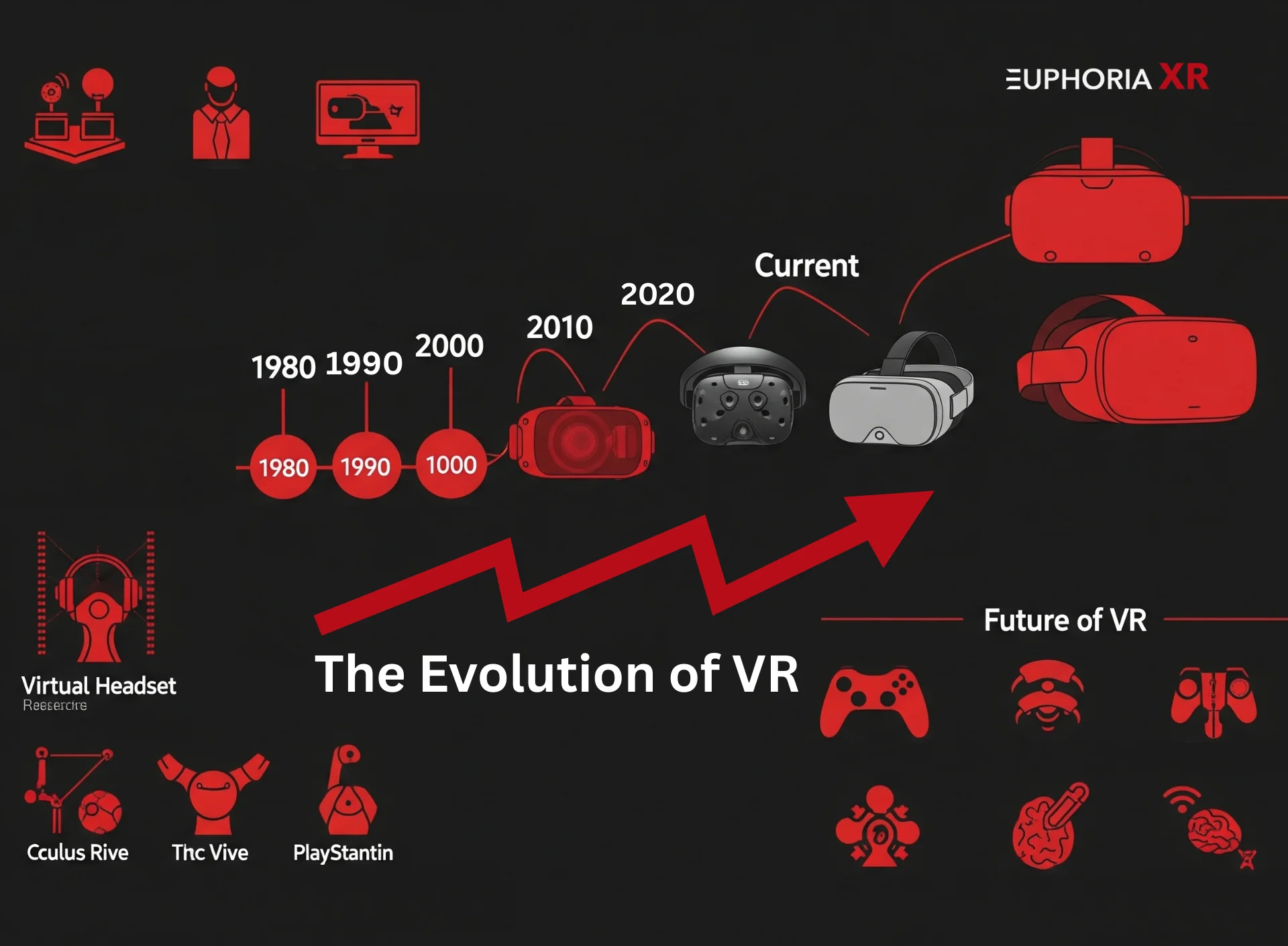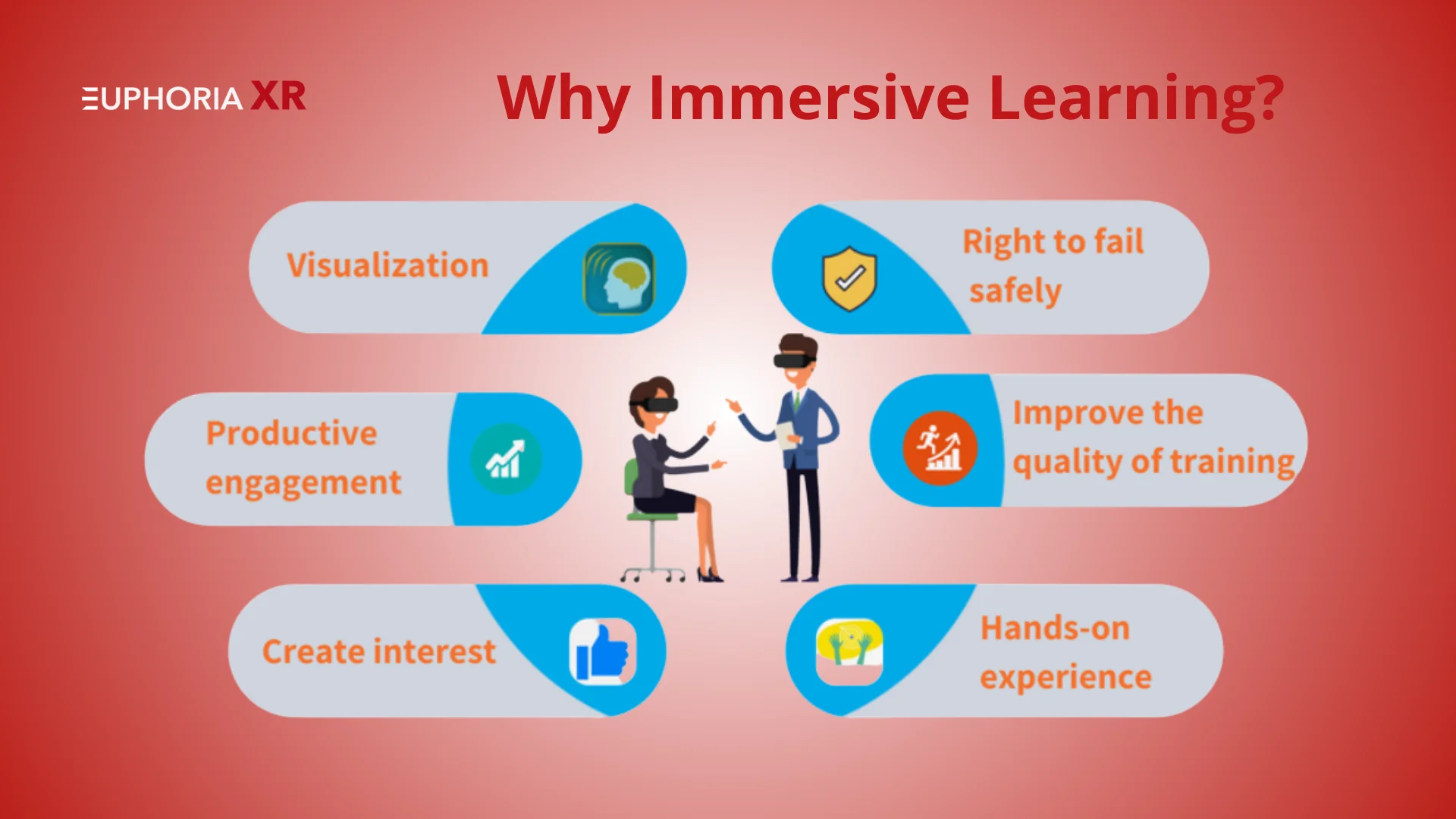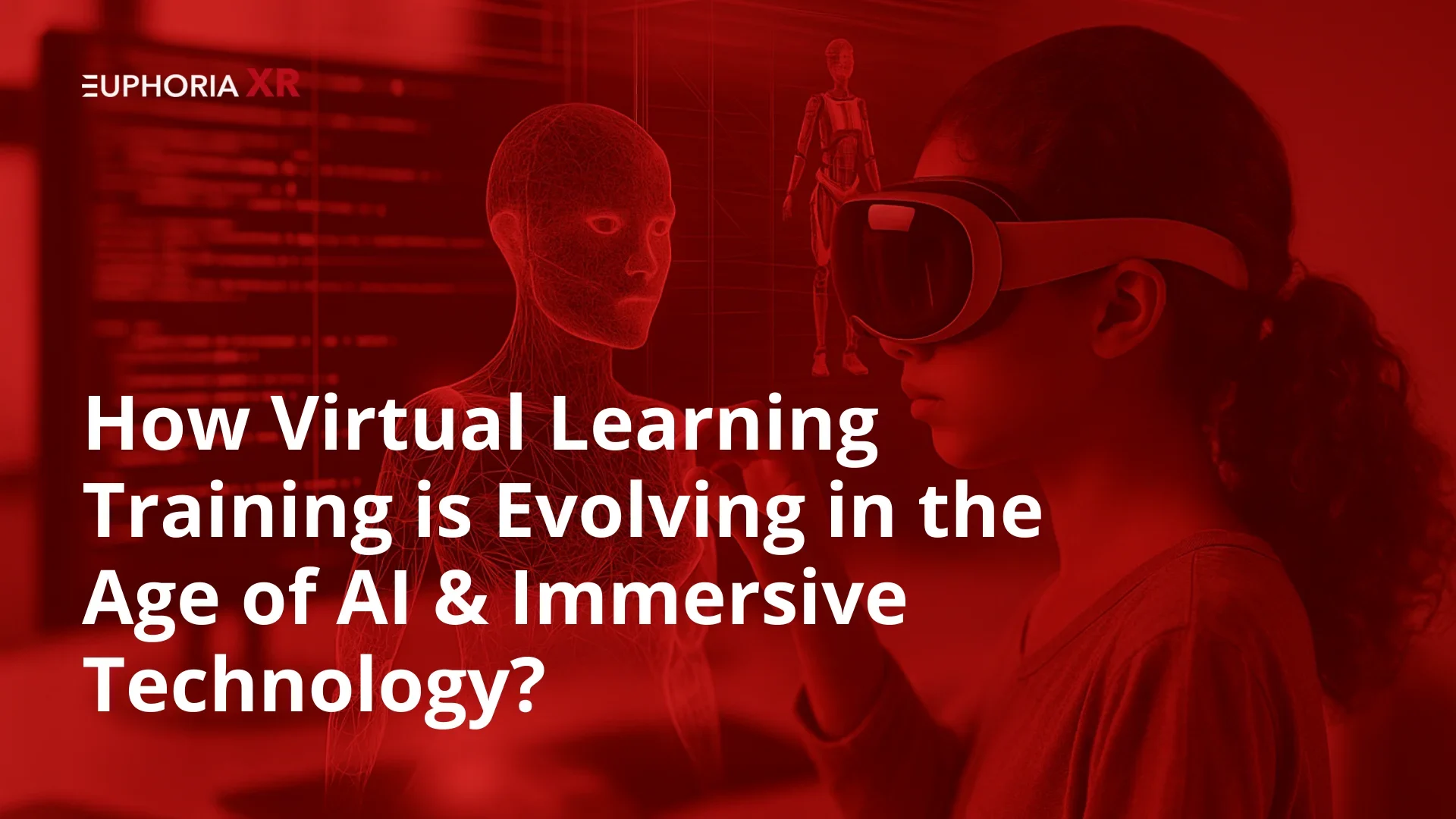What would happen if the learning at work, in schools, or in real life became as smart and then personal as Netflix or Spotify?
Just think about logging into a training platform that has already been pre-taught about where you were, where you need to go next, and how you need to be taught. No more cut-and-paste lessons and draggy videos that don’t look much at all like your objectives. What you do instead is get guided, interactive, and immersive learning experiences, but even more than this is the fact that they are quite tailored to you.
This is what virtual learning training is turning out to be nowadays: an artificial intelligence walk with the involvement of augmented reality (AR), virtual reality (VR), and intelligent automation tools. It is not so much about how classrooms could be replaced with screens; it is about the creation of dynamic learning ecosystems that could evolve in real-time, engage all your senses, and open new insights.
Virtual learning training provides flexible and on-demand learning opportunities, and impactful experiences that cannot only be replicated in real-life classes but are also relevant whenever you need to upskill at work, develop new staff, prepare emergency procedures, learn how to conduct high-stakes tasks, etc.
And it does not follow that it is merely a fashion; it is a revolution. Global Industry Analysts estimate that eLearning across the globe is projected to reach 457.8 billion by 2026. Businesses, schools, and institutions all over the planet are investing in smarter and more scalable channels that can be used to teach and train- because the old ways no longer work.
This blog will guide you on how AI and immersive technologies have been changing virtual learning training, and what they hold for the future of educational work and human potential.
The Evolution of Virtual Learning Training

How has Virtual Learning Training Transformed Over Time?
The rush into virtual learning training only a few years ago consisted of little more than pointing and clicking on a PowerPoint presentation or video instruction tapes. It was dull, usually one-size-fits-all, with few exceptions, and was passive. The students were forced to accommodate the content; it did not matter whether they fitted their pace, level of experience, or aspirations.
And then jump to the present, and the transformation has been radical.
The modern learning systems are more intelligent, quicker, and highly personal. They examine how users behave to individualize their lessons in real time, as opposed to how other learning platforms treat their users: supplying the appropriate content at the appropriate level at the precise moment.
It is no longer stagnant education. It is an experience of being responsive to the living.
Want to find the latest 3D service? Collaborate with one of the best Virtual Reality Development Companies to realize your immersive concepts.
From Static Lessons to Personalized Training Journeys
The ancient training systems were much like an assembly line; everyone was moving at the same pace, although there could be a great need. However, not everyone learns in the same manner, and there is no time or resource that a business can afford to lose in its learning process.
This is where personal virtual learning training will come in.
Current AI-powered systems examine the skill level, engagement, and aspirations of every learner and establish the custom road ahead. An example would be that a learner at a beginner level would be given additional introductory modules, whereas an advanced user would be shown only the advanced module. This individualization increases retention and quickens the progress.
Why Traditional Training Models No Longer Work?
Our world of work is evolving quickly to be supported by technologies such as automation, geographically distributed groups, and emerging technologies. There is no way that a static training system can keep pace.
The conventional models tend to:
Trust to take too long to develop
Obsolete in a short time
Lack engagement
Are difficult to scale
Also, they are costly. Organizing face-to-face trainings, recruiting trainers, printing workbooks, all these will cost a lot in a short time. All these issues are resolved through virtual learning training due to its on-demand, scalability, and always-up-to-date nature.
Trainees today are accustomed to the smoothness and engagement of the apps used in their everyday lives, so it is expected that they want training to be just as smooth and engaging. That is what your system must be able to provide, or they will tune out, and that will not help performance, retention, or ROI.
AI-Powered Virtual Learning Training Systems
Personalization and Predictive Learning in Virtual Training
The present-day virtual learning training systems are no longer electronic classrooms; they are smart systems that acquire knowledge about the learner.
With the AI, algorithms are deployed to identify how students engage with materials. In case a person is weak in a concept, the system will react by providing reinforcement activities. It is more sophisticated in content in case another learner sails through a module. This makes the learning process a real action-planning course with customization for an individual.
It is like a GPS of your learning experience, constantly recalculating where you are and where to go next.
The brightest example is Docebo, an AI-driven LMS, which delivers custom learning routes reliant on the behavior of users and offers recommendations regarding the content to learn. In the same manner, Cornerstone OnDemand uses AI to forecast what course or skill is best next to pursue professionally.
There are no longer any accidents. Smart, individualized, and at-scale growth.
Role of AI Tutors and NLP Feedback in Virtual Learning Training
All students cannot get access to a live instructor on the clock, but AI tutors can play the role of a tutor immediately and continually.
AI educators, driven by Natural Language Processing (NLP), can:
Speak in answer to questions
Provide quick feedback
Find the schema of either confusion or repetition
Redirect learners to the right path
These tutors make the virtual learning training more humane, more attractive, and much more efficient.
As an example, such solutions as Socratic by Google and the Quickstart of Khan Academy AI Coach (run on GPT) can already provide context-sensitive answers, break down concepts, and assist students in interpreting a complex issue with the help of conversational AI.
The beauty? This assistance applies to thousands of people, and it does not miss the personal aspect.
Using AI to Evaluate Performance and Boost Retention
You get tested at the end in the traditional models. When studying virtual learning with the help of artificial intelligence, you are evaluated everywhere, without letting you know it, step by step, in real-time, and correctly.
AI tracks:
Module time
Patterns and quiz score
Repeated mistakes
Drop-off points
It is then able to use this data to:
Adjust the difficulty of the content
Recommend reviews
Improve desirable information and increase recoverable memory according to the need
Systems such as LearnUpon and TalentLMS are incorporating AI analytics to allow L&D teams to determine how effectively the learners are coping with learning, and where they may be lacking.
With the possibility to turn the passive reports into practical insights, AI helps learners not only complete courses but also learn and remember them.
Are you now ready to dive into the world of immersive tech and use it in your business? We can plot your path to VR.
Immersive Technology in Virtual Learning Training

AR and VR in Skills-Based Virtual Learning Training
Think of being able to learn how to fix a jet engine, work on a heavy machine, or even carry out surgery without a real environment like a classroom setting, but as an entity in a 3D environment that has everything simulated inside it. That is what augmented reality (AR) and virtual reality (VR) present in virtual learning training.
AR forces digital content to be superimposed into the real world, such as visual instructions that could be projected on machines when repairing them where whereas in VR, a learner is put into an environment that resembles the real one into which s/he can practice, fail, and repeat safely.
These tools are also of high value in places where the risks are high, such as:
Aerospace
Automotive
Healthcare
Engineering
Immersive learning transfers the trainees into the muscle memory, critical thinking, and confidence without consequence to the real world.
Among them, one can single out the example of Walmart that utilizes VR training simulations to educate more than a million workers on customer service, emergency response, and the release of new technologies. The result? More confidence, improved memory, and less time required to train.
Simulation-Based Virtual Learning for High-Stakes Training
There are jobs that you can not teach using slides or lectures. Pilots, surgeons, firefighters, and nuclear technicians, working under pressure and with the stakes high, this is the kind of job.
Simulation-based training provides the learners with realistic practice environments wherein they can:
Emergency response
Complex solving of problems
Test stress decision-making
It is a major advantage in an enterprise-level training procedure because this type of learning helps in enhancing performance by retaining many of the skills and causes a decrease in performance anxiety.
Indeed, Johns Hopkins has incorporated VR surgery simulations that can enable medical students to practice a given procedure as many times as necessary before stepping into the operating room.
AR-Powered On-the-Job Guidance and Just-in-Time Training
AR is no longer used only in gaming; it is an on-site coach.
Consider a situation where you have smart glasses that take you through step by step, and in that way, show instructions over the equipment that you are working on. This is called just-in-time training, which is learning on the job, when the knowledge is needed most.
The technique is especially viable in:
Manufacturing
Field service
Warehousing
Energy and utilities
As opposed to pausing in order to read manuals, workers learn on the fly-enhancing accuracy and productivity rates.
A statement released by companies such as Boeing and Bosch shows that they have implemented workflows enabled by AR where the chances of making errors are minimized and the time taken to train technicians is minimized, but not taken out of the environment.
Blended Reality Labs in Technical Virtual Training
Other learning cannot be provided in real-life labs because it is too difficult or too costly. That is solved with blended reality labs.
They integrate the use of physical devices alongside virtual worlds to make the learners engage in simulations more practically. You can imagine it as a science lab with holograms and interactive overlays that react in real time.
Blended Labs are good at the following:
Engineering design
Anatomy and zoology
Physics simulations
Automation anders
They provide experiments in a secure environment, comprehensive knowledge, and enormous scalability, in particular, in distant or underserved regions.
Turn your project into reality quickly. Hire a VR Developer who possesses real-time simulation and 3D experience to achieve the best.
Real-World Use Cases of Virtual Learning Training
Manufacturing Upskilling with Virtual Learning and AR/VR
The ever-evolving manufacturing landscape is continually rolling out novel tools, machines, and safety protocols. For this reason, equipping workers with new skills while operations remain in full flow is an immense challenge.
Capable of harnessing AR and VR, virtual learning training conquers the challenge by letting employees practice genuine tasks in simulated factories or by projecting AR overlays onto real-world machinery.
This form of learning:
Reduces the frequency of errors and the intervals of downtime.
Across the enterprise, it shaves weeks off new employee onboarding.
Permits practice to be rehearsed time and again, while avoiding the waste of materials.
By tapping into exceptional, immersive training platforms, forward-thinking companies such as Siemens and GE can equip their workforces with assembly-line duties and safety procedures while foregoing live instructors and online teaching spaces.
AI Tutors in Financial Sector Training Programs
The financial sector continues to be one of the most stringently regulated industries. Although skill in compliance, risk assessment, and ethical conduct continues to be vital, traditional instructional models still endure as being viewed as dreary and hard to extend effectively.
So, enter AI tutors.
With the adoption of artificial-intelligence-assisted learning environments, financial institutions will be able to:
Let real-world in-field compliance scenarios spring from the page and come to life vividly.
Evaluate ethical reasoning through scenarios that are presented in real time.
Rewrite in real time by chatbots.
Consequently, training turns out more swiftly, more intelligently, and with greater uniformity, particularly among globally dispersed teams. Likewise, institutions benefit from thorough overviews of learning gaps, which grant them the chance to intervene early.
Higher Education Adopting AI + Immersive Virtual Learning
Institutions of higher learning realize that students today demand more than slide decks and extended lectures.
Students can:
Direct themselves to learning routes that are meticulously developed in their area of choice of profession.
Participate in live lessons customized in real time to their performance.
Engage in virtual laboratories that immerse students in learning by allowing them to explore hands-on practice.
An increasing number of universities are adopting digital cadaver resources to bolster medical education and furnish immersive XR environments for architecture and design, all while enhancing instruction by making it at once more immersive and demonstrably more effective.
With constant improvements in this sphere, universities increase their competitiveness and provide their students with the skills required to perform in future job positions that will be greatly influenced by the influences of technology.
Cost-Effectiveness of Virtual Learning Training Models
Comparing Traditional Training Costs with Virtual Learning Training
Training face-to-face, paying off those who facilitate, printing manuals, and barraging travel, all this can cost a lot of money very quickly.
These costs are considerably minimized by virtual learning training.
When a program has been developed:
It can be provided over and over again at little cost
It saves logistic pressure, thus learners can access it remotely
They can be changed at any time without reprints and rescheduling
That is why companies such as IBM and Walmart transferred a huge part of their training activities to online ones, netting millions of dollars a year.
Licensing, Scalability, and ROI of Modern Training Platforms
New virtual training systems were built in a cloud-based model, which enables the companies to license such training tools as:
LMS ( Learning Management Systems)
AI tutor add-ons
AR/VR simulations
Such systems are:
5 to 50,000+ users, very scalable
Rich in data-based analytics are in real-time
Doesn’t need any maintenance: automatic update is also possible
To the businesses, this implies an increased investment in training returns (ROI), increased enthusiasm by the trainees, and reduced interruption to the daily activities.
Need an idea for a project? So what are you waiting for? Become part of something immersive now.
Challenges in Adopting Virtual Learning Training
Integrating Virtual Learning into Legacy Training Systems
The outdated infrastructure is also one of the largest barriers a company can have when it is time to transition to new training tools. The outdated LMS systems, in-house databases, or even manual tracking systems are still used by many, and these tools do not go along with the AI or the immersive technologies.
Incorporation of a new virtual learning environment usually demands:
Cloud upgrade of hardware or architecture
Performing system compatibility
Teaching care of tech with inside teams
Organizations that operate on low budgets or those having a non-technical labor force find this process overwhelming. Integration is, however, a more flexible concept in the form of modularity on modern API-friendly platforms, as it enables a gradual implementation instead of comprehensive system replacement.
Overcoming Learner Resistance and Driving Adoption
With all the excellent technology, the whole virtual learning training seems wasteful when people are not willing to undertake it.
Part of the learners are resistant to change, in particular, they might have adopted a hands-on or face-to-face kind of environment. Other people fear learning to operate new sites or are afraid of being left behind.
Successful programs overcome this by using:
User-friendly interfaces that are mobile-first.
Microlearning and gamification to create engagement
Reducing tech intimidation on the onboarding tours
Awards or stimuli to enhance motivation
A well-communicated rationale explaining why the change is taking place can dramatically increase the level of uptake and support throughout the change.
Solving Content Creation Bottlenecks in Virtual Learning Training
The platform is one thing, but the content is another.
The development of immersive or AI-ready learning content requires time, imagination, and expert abilities. Development processes can delay deployment, especially in the case of industries that are compliance-heavy or industries that need simulation.
This is how the top teams are resolving it:
Creation of video-based modules using AI content generators (such as Synthesia)
Implementing a modular quiz, tutorials, and a branching scenario template.
Curriculum creation in partnership with subject matter experts (SMEs)
The trick is to start small, pilot fast, and iterate, not to shoot a perfect course on the first day.
Need customized AI logic to use in your XR experience? Enable smart interactions in your next-generation solution.
The Future of Virtual Learning Training
Emotion-Aware and Multi-Sensory Learning Environments
Smart will be replaced by emotionally intelligent learning platforms in the future. Virtual training tools will be able to perceive confusion, stress, or boredom by using facial recognition, voice tone analysis, and biofeedback sensors, to dynamically change in real time.
When multi-sensory technology such as spatial audio, haptic feedback, and motion tracking is added, such environments will be able to simulate real-world experiences to a greater extent, to make the knowledge stick long-term, and understand it better.
Cross-Platform, Edge-Based Virtual Learning Training Delivery
Modern students change gadgets regularly, and education should work in the same manner. Virtual learning training can be used on phones, tablets, desktops, and VR headsets with edge computing and in low-bandwidth environments.
Here, this would guarantee easy delivery: whether in a classroom, in the home, or in business production, the learning process becomes more accessible than ever.
Adaptive, Immersive, and Measurable Training Models Ahead
The future will be adaptive in every single way. AI-based platforms will not only tailor the content, but also the pacing, difficulty, and mode of delivery. Any contact, the good and the bad, will result in a refeed into the system, so the training becomes more intelligent and customized.
And with real-time analytics, organizations will have precise measures of engagement and progress, and outcomes, unlocking new performance-enhancement avenues.
EuphoriaXR’s Role in Redefining Virtual Learning Training
EuphoriaXR’s AI + XR Solutions for Training and Education
As a market leader in the realm of Virtual Reality Learning, EuphoriaXR has been actively developing the intersection of artificial intelligence and extended reality (XR) as an immersive experience that brings results in training.
Their AI + XR solutions are fully tailored to enable companies and educational institutions to go beyond past methods of learning and become part of the new world of learning, the world that feels real and can provide results.
Scalable, Engaging, and Results-Driven Virtual Training Systems
The training experiences of EuphoriaXR are:
Extremely scalable to anything above more than teams
Immersive experiences and special visual experiences
Planned to have skill-building, done in measurable steps, and retention
Their systems will assist in reducing the learning to performance gap, whether training factory workers, teaching ridiculously complicated academic concepts, or onboarding at scale.
Conclusion
Virtual learning training has become more of an essential need and less of a want by organizations and institutions intending to remain relevant and flexible enough to meet the future.
As AI/AR/VR and emotion-aware technologies enter the training landscape, training is no longer a passive thing to watch, as it becomes a personalized experience that will adjust to every learner. Be it upskilling the frontline workers, creating analogs of high-stakes environments, reinventing the way universities train, or creating ROI-driven learning and higher education, the new way is leading to happier results, faster learning, and ROI.
And as we can see with companies like EuphoriaXR putting in place scalable, intelligent training systems, the learning experience is even more engaging, more human, and even more effective than ever.
The only question now is not whether you will take up virtual learning training, but when. Since innovation and education are the real future of the workforce and learning. It is immersive.















